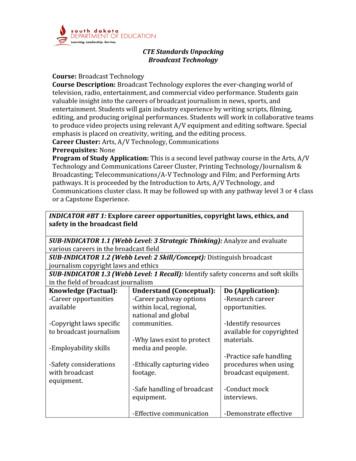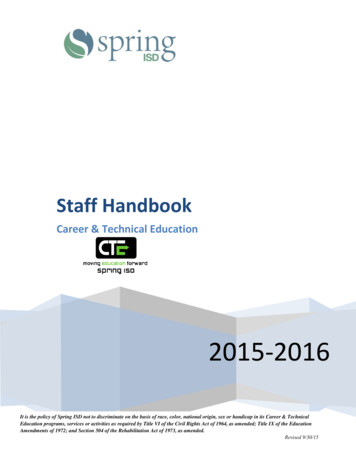CTE Standards Unpacking Broadcast Technology
CTE Standards UnpackingBroadcast TechnologyCourse: Broadcast TechnologyCourse Description: Broadcast Technology explores the ever-changing world oftelevision, radio, entertainment, and commercial video performance. Students gainvaluable insight into the careers of broadcast journalism in news, sports, andentertainment. Students will gain industry experience by writing scripts, filming,editing, and producing original performances. Students will work in collaborative teamsto produce video projects using relevant A/V equipment and editing software. Specialemphasis is placed on creativity, writing, and the editing process.Career Cluster: Arts, A/V Technology, CommunicationsPrerequisites: NoneProgram of Study Application: This is a second level pathway course in the Arts, A/VTechnology and Communications Career Cluster, Printing Technology/Journalism &Broadcasting; Telecommunications/A-V Technology and Film; and Performing Artspathways. It is proceeded by the Introduction to Arts, A/V Technology, andCommunications cluster class. It may be followed up with any pathway level 3 or 4 classor a Capstone Experience.INDICATOR #BT 1: Explore career opportunities, copyright laws, ethics, andsafety in the broadcast fieldSUB-INDICATOR 1.1 (Webb Level: 3 Strategic Thinking): Analyze and evaluatevarious careers in the broadcast fieldSUB-INDICATOR 1.2 (Webb Level: 2 Skill/Concept): Distinguish broadcastjournalism copyright laws and ethicsSUB-INDICATOR 1.3 (Webb Level: 1 Recall): Identify safety concerns and soft skillsin the field of broadcast journalismKnowledge (Factual):Understand (Conceptual): Do (Application):-Career opportunities-Career pathway options-Research careeravailablewithin local, regional,opportunities.national and global-Copyright laws specificcommunities.-Identify resourcesto broadcast journalismavailable for copyrighted-Why laws exist to protectmaterials.-Employability skillsmedia and people.-Practice safe handling-Safety considerations-Ethically capturing videoprocedures when usingwith broadcastfootage.broadcast equipment.equipment.-Safe handling of broadcast-Conduct mockequipment.interviews.-Effective communication-Demonstrate effective
(written and verbal).and appropriateinteractions withemployers and audienceBenchmarks:Students will be assessed on their ability to: Create a presentation showcasing a career or a variety of careers available inthe Broadcast field. Demonstrate employability skills applicable to broadcast journalism. Create a safety checklist for studio and field broadcasting.Academic ConnectionsELA Literacy and/or Math StandardSample Performance Task Aligned to(if applicable, Science and/or Socialthe Academic Standard(s):Studies Standard):L.1 Demonstrate command of theconventions of standard Englishgrammar and usage when writing orspeaking-Broadcast Journalism presentationSL.4 Present information, findings, andsupporting evidence clearly, concisely,and logically such that listeners canfollow the line of reasoning and theorganization, development, substance,and style are appropriate to purpose,audience, and task.-Career presentation of Broadcast fieldINDICATOR #BT 2: Demonstrate proper use and terminology of broadcastequipmentSUB-INDICATOR 2.1 (Webb Level: 2 Skill/Concept): Summarize broadcastequipment and terminologySUB-INDICATOR 2.2 (Webb Level: 2 Skill/Concept): Execute proper use ofbroadcast equipmentKnowledge (Factual):Understand (Conceptual): Do (Application):
-Identify equipment usedin broadcast.-Function of variousbroadcast equipmentused.-Importance and/or impactof proper use of equipmenton the finished product.-Properly use broadcastequipment.-Use industry specificterminology forbroadcast media.-Set-up equipment tomeet guidelines.-Maintain equipment.-Troubleshoot technicalissues.-Properly take down andstore equipment.Benchmarks:Students will be assessed on their ability to: Prepare a presentation using appropriate terminology, demonstrating theproper use of the equipment. Create a checklist of steps, including industry-specific terminology, to meetproject expectations.Academic ConnectionsELA Literacy and/or Math StandardSample Performance Task Aligned to(if applicable, Science and/or Socialthe Academic Standard(s):Studies Standard):RI.4 Determine the meaning of wordsand phrases as they are used in a text,including figurative, connotative, andtechnical meanings; analyze how anauthor uses and refines the meaning ofa key term or terms over the course of atext-Steps with industry-specificterminologyL.6 Acquire and use accurately generalacademic and domain-specific words-Demonstration of proper use ofequipment using correct terminology of
and phrases, sufficient for reading,writing, speaking, and listening at thecollege and careerreadiness level; demonstrateindependence in gathering vocabularyknowledge when considering a word orphrase important to comprehension orexpression.careerINDICATOR #BT 3: Create original broadcast performancesSUB-INDICATOR 3.1 (Webb Level: 4 Extended Thinking): Produce media projectusing broadcasting tools and terminologySUB-INDICATOR 3.2 (Webb Level: 4 Extended Thinking): Analyze and evaluatestudents' broadcastsKnowledge (Factual):Understand (Conceptual): Do (Application):-Various video genres.-Workflow of video-Create a story throughproduction (pre-production, character and plot.-Criteria for videoproduction, postdevelopmentevaluation.production).-Use storyboard to-When and how to employvisually display storyline.-Story developmentvideogenresprocess.-Self-evaluation of mediaproject.-Production Crewpositions.-Duties of productioncrew.-Group evaluation ofmedia project.-Different types ofbroadcast.Benchmarks:Students will be assessed on their ability to: Collaboratively develop a broadcast project using the story developmentprocess.Academic ConnectionsELA Literacy and/or Math StandardSample Performance Task Aligned to
(if applicable, Science and/or SocialStudies Standard):the Academic Standard(s):SL.1. Initiate and participate effectivelyin a range of collaborative discussions-Group discussion to plan storydevelopment processSL.4 Present information, findings, andsupporting evidence clearly, concisely,and logically such that listeners canfollow the line of reasoning and theorganization, development, substance,and style are appropriate to purpose,audience, and task.-Evaluation of broadcast projectINDICATOR #BT 4: Compare and contrast professional broadcastsSUB-INDICATOR 4.1 (Webb Level: 3 Strategic Thinking): Evaluate professionalbroadcastsKnowledge (Factual):Understand (Conceptual): Do (Application):-Elements that make a-The impact of videography -Working collaboratively,professional broadcast.techniques, audio, writing,use a rubric to analyzestyle, and organization have professional broadcasts.on the end result of abroadcast.Benchmarks:Students will be assessed on their ability to: Compare and contrast multiple professional broadcasts, and present results.Academic ConnectionsELA Literacy and/or Math StandardSample Performance Task Aligned to(if applicable, Science and/or Socialthe Academic Standard(s):Studies Standard):W.8 Gather relevant information from-Multiple professional broadcastsmultiple authoritative print and digitalevaluationssources, using advanced searcheseffectively; assess the usefulness of eachsource in answeringthe research question; integrateinformation into the text selectively tomaintain the flow of ideas, avoidingplagiarism and following a standardformat for citation.
SL.2. Integrate multiple sources ofinformation presented in diverseformats and media-Analyze professional broadcastsAdditional ResourcesPlease list any resources (e.g., websites, teaching guides, etc.) that would help teachersas they plan to teach these new o-assess-students-inbroadcast-journalism/Radio Broadcast Rubric.doc10 Ideas for Classroom Video Projects http://educationaltechnology.ca/couros/212720 Video Project Ideas rojectideas-to-engage-students/Media Resources http://www.mediacollege.comRadio Broadcast Rubric .docHow to set up equipment and studio(https://www.youtube.com/watch?v GX4NT5PrZj8)TV Studio Safety Procedures (http://class.csueastbay.edu/tvstudio/safety guide.pdf)Reading Guide for Contracts ract/)Broadcast Legal and Ethics (http://cybercollege.com/tvp067.htm)Copyright laws (http://www.copyright.gov/title17/)Teaching Copyright D MY LIFE (www.sdmylife.com)National Association of Broadcasters (www.nab.org)SD Broadcasters Association (www.sdba.org)
CTE Standards Unpacking Broadcast Technology Course: Broadcast Technology Course Description: Broadcast Technology explores the ever-changing world of television, radio, enter
12 Summer Data -410 CTE Attendance: * Collected only in the summer submission. * 410 Attendance requires the student has a valid CTE Indicator code on the 101 record. * Each student enrolled for more than two hours in a valid CTE course must have a 410 record. * "V" Codes: * V1 45-89 ave. minutes per day in a CTE course * V2 90-149 ave. minutes per day in a CTE course
CTE standards and 13 states and two territories have state-approved postsecondary standards. Only two states and one territory have CTE standards that are fully aligned between secondary and postsecondary systems. X The majority of states have the authority to adopt both secondary and postsecondary CTE standards, although most
New York State Work Experience Requirements by CTE Title SECTION C. BECOMING A CTE TEACHER C1. CTE Resume Example C2. The CTE Hiring Process C3. Applying for Salary Increase SECTION D. APPLYING FOR A CTE TEACHING CERTIFICATION D1. Steps to Applying for a Trans-A Certificate with NYSED D2. Trans-A Requirements for All NYS Teacher Applicants D3.
CTE Overview 3 CTE Department Contacts 4 Career Pathways 2015-2016 5 CTE Course List 2015-2016 6 CTE Curriculum & Resources 8 Professional Development Requirements 9 CTE Advisory Board 14 Career Cluster Coordinator Guidelines 15 Career & Technical Student Organizations (CTSOs) & Sponsorship 18 Certification Reporting 23
Virginia includes CTE courses within 16 career clusters, each with multiple pathways designed by the school divisions. For example, the Health Science career cluster may include pathways for therapeutic services, biotechnology, or diagnostic services. CTE credential. A CTE credential certifies that a student has mastered specific CTE content.
CTE Standards Unpacking Nutrition and Wellness Course: Nutrition and Wellness Course Description: Nutrition and Wellness educates students to make healthy lifestyle choices for personal, family, and career success across the lifespan. Topics include the impact of technology on nutrition, food choices, wellness and stress
past few years have systematized and revamped their standards in the program of career and technical education (CTE). Nearly every state in the union has worked hard to redesign its CTE standards into coherent courses and plans of study, organized for the most part into the 16 Career Clusters defined by Advance CTE. In addition, state .
Animal Nutrition & Health addresses the nutrition additives segment of the feed and pet food markets. Human Nutrition & Health largely addresses nutrition and functional ingredients segment of the food markets. Personal Care is focusing on the actives and ingredients in the sun care, skin care and hair care industries. DSM is the only producer who can supply the lawsuits, and public rejection .






















